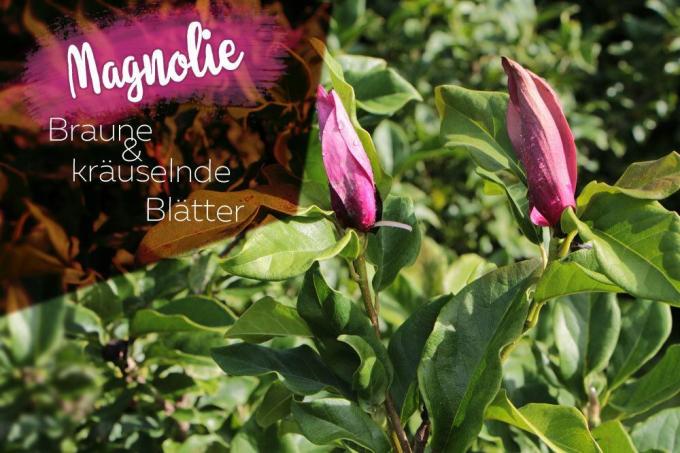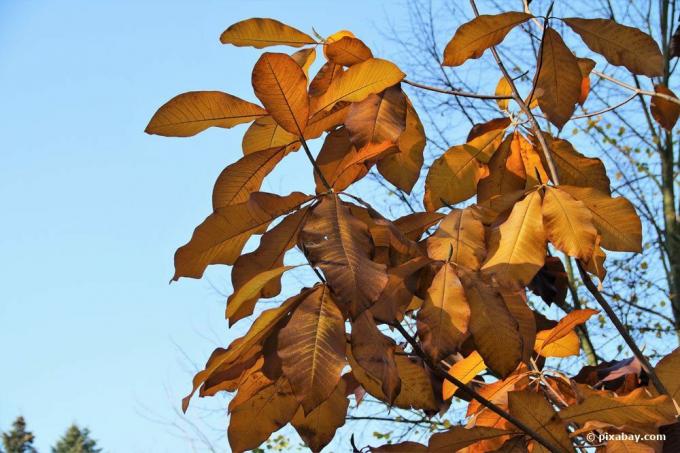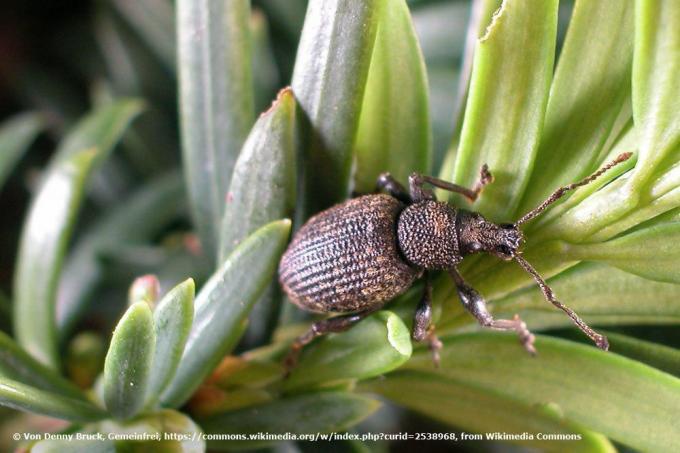
table of contents
- Brown leaves
- Nutrient deficiency / over-fertilization
- Drought / waterlogging
- Root damage
- Late frost
- Leaves have brown spots
- Magnesium deficiency
- Leaf spot disease
- Leaves curl up / curl up
- dryness
- Pests
A healthy one magnolia shows large, strong green leaves, which in many species cultivated in this country turn yellow in autumn and are thrown off. However, if the foliage of the deciduous magnolias turns brown or yellow in spring or summer, the cause is mostly to be found in an unsuitable location and / or incorrect care. Furthermore, there are fungal diseases or Pests as the cause of the problem, although these rarely appear.
Brown leaves
A brown discoloration of the magnolia leaves can have various causes, which are mostly due to an unsuitable location and / or incorrect care. Before taking hasty countermeasures based on a suspicion, the first thing to do is to carefully identify the real cause: Sometimes Contrasting phenomena lead to the same symptoms, which is why a pure symptom rather than a causal treatment for the tree is fatal can.
Nutrient deficiency / over-fertilization
A good example of confusing symptoms is the fact that both a lack of certain nutrients and over-fertilization lead to a brown discoloration of the leaves. Take a closer look, because the specific type of discoloration can often be used to determine the cause:
- Leaves first turn brown at the edge, then inside: lack of potassium
- brown discolored leaf margins: overfertilization
- brown and dry leaves: alkaline and / or calcareous soil

measures
In the event of a potassium deficiency, fertilize the magnolia with a potassium fertilizer from the gardening store, which you work lightly with a rake into the root disc and then the tree vigorously water. Watering is especially important because the fertilizer gets to where it belongs so quickly: to the roots.
Brown discolored leaf margins, on the other hand, often indicate over-fertilization, in which you can quickly have to act: Often the only thing that helps here is to lean the soil with sand or to move the magnolia to another Location to transplant. However, this should really remain the last option, because the sensitive plants do not like repositioning at all. They often respond by shedding their leaves or even perishing.
The magnolia feels most comfortable in a slightly acidic substrate, which is why it quickly reacts indignantly to an alkaline substrate and its leaves turn brown and dry up. Remedy this by being plentiful Rhododendron soil Distribute it around the tree and work it lightly into the ground. Then you should water well!
Drought / waterlogging
If the magnolia appears to be drying up and therefore the leaves turn brown, are thrown off later and even entire twigs and branches wither, do not use the watering can immediately. This phenomenon arises not only due to severe drought, but can also result from a Waterlogging appear. If the magnolia is permanently in moist soil, the roots begin to rot after a while and can no longer absorb any water or nutrients. The above-ground parts of the plant literally starve and die of thirst because no more moisture is passed on. Waterlogging occurs mainly in heavy soils, but can also be the result of too well-intentioned watering behavior or heavy rainfall. On the other hand, magnolias are especially in longer dry phases, especially during the blossom and during the hot summer months, threatened by lack of water. This is especially true when they are on a rather dry surface anyway.
Countermeasures
- Dryness: pour vigorously and regularly, do not use tap water (calcareous!)
- Waterlogging: dig up the magnolia, cut back decaying roots and above-ground shoots, and move them to a new location
tip: Cut to be implemented Woods always back by a third, as the plants always lose part of their roots and the branches and shoots have to be cut back accordingly. Otherwise there may be supply bottlenecks, as the remaining roots can no longer supply all parts of the plant with sufficient water and nutrients.
Root damage
However, the causes of leaf discoloration do not always lie in things that could influence them: sometimes just have pests such as White grubs or vine weevils have an appetite for magnolia roots, which is why they eat them and the plant then no longer has enough water and nutrients can accommodate. In addition to the pests mentioned, the roots of the magnolia also taste very good for voles. If you suspect such a thing, take a closer look at the roots and the soil. The roots show signs of feeding, while thick maggots or grubs can be found in the ground. find the underground passages of the polluters.
measures
Basically, the only thing that helps against voles is to plant the magnolia within a protective cocoon, for example made of close-meshed wire netting, or to cultivate the tree in a large container. Above all, it helps against the light-colored larvae of the black weevil - a beetle that in its adult form prefers to eat holes in leaves - as well as against grubs Nematodesthat you can buy from specialist retailers and distribute directly in the affected root area. The bacteria penetrate the larvae and kill them within a few days.

Late frost
If not only the leaves, but also the buds and new shoots are discolored and dried up in spring, the cause is to be found in the late frost. The young shoots, the buds and the flowers in particular cannot tolerate frost and must therefore be protected in good time. In this case, there is currently nothing more you can do, just cut back the frozen parts of the plant and hope for the next year. Give the frozen tree some fertilizer, for example in the form of rhododendron soil distributed around the trunk, to stimulate new shoots.
Leaves have brown spots
Sometimes the leaves of the magnolia do not stand out because of their uniform brown coloration, but rather because of isolated brownish spots or dots. These are often caused by fungal pathogens, but not in every case.
Magnesium deficiency
A magnesium deficiency can often be observed in magnolias, after all they grow primarily on soils with a rather acidic pH value - and these in turn usually contain only a little Magnesium. In addition, many commercial universal fertilizers contain little or no mineral, so that a deficiency is practically inevitable.
Signs of magnesium deficiency
- yellow-green discoloration of the leaves
- brownish leaf spots
Countermeasures
A magnesium deficiency can be easily remedied, all you have to do is fertilize the magnolia tree with a commercially available special fertilizer according to the manufacturer's instructions. Epsom salt or magnesia are best for this purpose.
Leaf spot disease
The leaf spot disease shows itself by brownish to black leaf spots, which are often surrounded by a yellowish wreath. It occurs mainly during the summer months when it is cooler (approx. 15 ° C to 20 ° C) and damp weather and is transmitted by rainwater. This is where the causers of the disease cavort, which are bacteria of the species Pseudomonas syringae. An infestation must be treated, because in the further course the infection spreads to shoots and branches, which dry up and die.
Countermeasures
In the event of an acute infestation, there is nothing more you can do than remove the infected parts of the plant as quickly as possible possible with clean and sharp secateurs or another suitable cutting tool remove. The clippings should not be composted or simply left in the garden. The bacteria overwinter in it and can continue to spread from their new location. Instead, burn the cut plant parts or dispose of them with household waste.
tip: Prevention is the best way to combat the common leaf spot disease. Make sure that the magnolia is in an airy location, has enough space on all sides and that its crown does not grow too densely. The leaves must be able to dry off quickly after a downpour so that any bacterial pathogens have no chance of penetrating them.
Leaves curl up / curl up
It is also advisable to take a closer look if the magnolia leaves suddenly curl or curl inwards from the edges. There are also various possible causes for this.
dryness
The curling of the foliage is a typical protective mechanism that prevents the plant from evaporating valuable moisture when it is dry. As the magnolia tree reduces the leaf surface by rolling or curling, less water is released into the surrounding air. This mechanism often occurs during longer dry periods and especially during the hot summer months. It is practically the preliminary stage before the leaves and shoots dry out due to lack of water.
Countermeasures
Carefully loosen the soil around the magnolia stem with a Garden hoe on. However, do not damage any of the roots running close to the surface. Then water the thirsty tree piercingly. Repeat this measure in the following days and weeks. You can also mulch the root area and thus keep the moisture in the soil longer.
Pests
Before you water the magnolia completely unnecessarily, however, first examine the rolling or rolling. Carefully curl deformed leaves for pests. Pests sucking leaf sap, such as aphids, scale insects or whiteflies, should be driven away as they are frequent They are carriers of fungal diseases - or other problems, such as an invasion of ants or a stubborn sooty fungus draw. An infestation is often indicated by yellowish to brownish leaf spots.
Countermeasures
If the pest pressure is not yet too pronounced, spraying with a self-made nettle brew often helps. Repeat this measure several times with an interval of a few days. In the event of a strong infestation, however, only an insecticide suitable for outdoor use will help. You dilute this with water so that you can treat larger areas effectively.
tip: Useful help against pests insects like predatory bugs, earwigs or ladybugs are best. Build a comfortable insect hotel near the magnolia tree and prevent infestation with aphids and the like.

